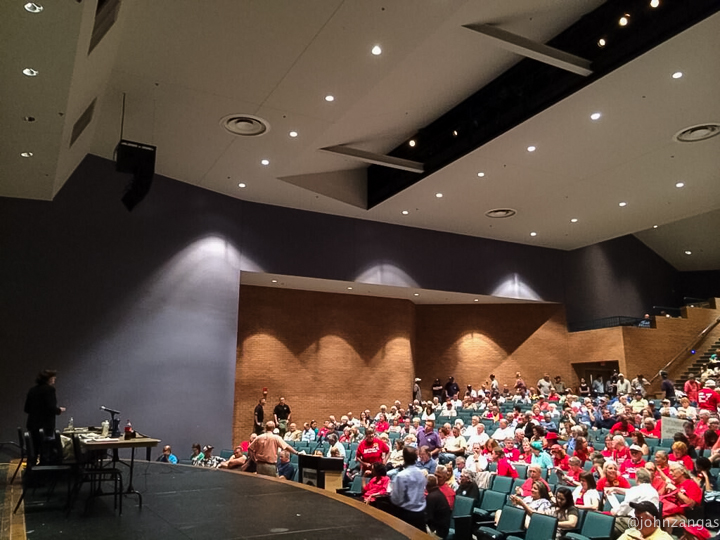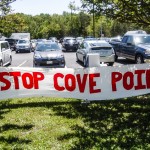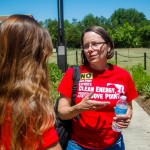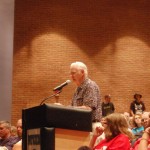Hundreds filled the auditorium of Patuxent High School in Lusby, Maryland on May 31, eager to tell two representatives from the Federal Regulatory Energy Commission (FERC) how they feel about the agency permitting a plant to export natural gas. In a marathon hearing lasting more than six hours, 150 people spoke out for and against the project. In general supporters expressed the sentiment, “Let’s get on with it,” while those opposed said, “FERC is failing us.”
Two years ago, Dominion Resources filed its application with FERC to add on to the existing Cove Point facility and ship out liquefied natural gas on tankers bound for Asia. Now, two weeks after FERC released its draft Environmental Assessment favorable to Dominion, many eyes are watching as the regulatory process goes into the final stretch. Among a labyrinth of federal and state agencies which must issue permits before construction gets the go-ahead, FERC will likely have the final say.
 A lot is riding on this project’s approval for Dominion and its bottom line, and it will affect not only the small town of Lusby but the state and region as well with polluting and greenhouse gas-emitting facilities and infrastructure. As potentially one of the first LNG export facilities to become operational in the US, Cove Point has attracted national and even global attention. Saturday’s hearing was the sole opportunity to weigh in publicly on FERC’s recent report. The type of evaluation which FERC conducted has been criticized as insufficient, not taking into consideration the full impacts of extracting, transporting, liquefying, shipping and burning natural gas–from the hydraulic fracking wells of the Marcellus Shale to ports and power plants in Japan and India.
A lot is riding on this project’s approval for Dominion and its bottom line, and it will affect not only the small town of Lusby but the state and region as well with polluting and greenhouse gas-emitting facilities and infrastructure. As potentially one of the first LNG export facilities to become operational in the US, Cove Point has attracted national and even global attention. Saturday’s hearing was the sole opportunity to weigh in publicly on FERC’s recent report. The type of evaluation which FERC conducted has been criticized as insufficient, not taking into consideration the full impacts of extracting, transporting, liquefying, shipping and burning natural gas–from the hydraulic fracking wells of the Marcellus Shale to ports and power plants in Japan and India.
Those in support of Cove Point universally cited jobs and economic benefits to Calvert County and the state of Maryland.
“We need more of these projects, not fewer,” said Henrik Sorensen, Vice President of Carpenters Local 132. If FERC questions the net benefit of Cove Point to the state, he said, then it should rely on the opinion of the Maryland Public Service Commission, which just issued a conditional permit to the onsite generating station only the day before.
But Mike Tidwell of Chesapeake Climate Action Network called the Maryland Public Service Commission ruling “flawed,” except in one respect. “It does however state that this plant is not in the best economic or environmental interest of the state,” Tidwell said. “In fact, the Maryland Public Service Commission said basically that this power plant liquefaction of fracked gas for export would harm the state and has required Dominion to pay $48 million to compensate the state.”
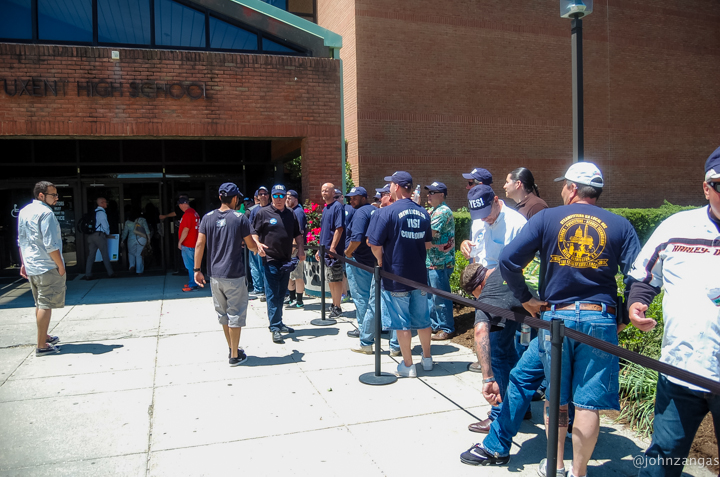
Estimates of the number of jobs created by Cove Point expansion vary. Dominion puts the number of new permanent jobs at 175 in a public relations brochure. Mike Frederick, VP of LNG Operations at Dominion Cove Point, said on Saturday that 75 permanent jobs would be created. The FERC Environmental Assessment says there would be 93. Yet only 26 new permanent jobs would be created for the whole project, according to the Maryland Department of Natural Resources estimate cited in the Maryland Public Service Commission report.
Over the three-year period prior to operation, temporary construction jobs would likely number in the thousands. Labor unions are eager to fill them.
Daniel Loveless of the United Association of Steamfitters said that Dominion was offering 600 skilled jobs, including 177 welding jobs. “It’s difficult to find that many talented welders that can handle this sort of a project,” he said. “We’re hoping that this project is launched, and we can put some people to work.” Union members as far away as Richmond and Baltimore would be called on to fill the need.
But not every union worker lines up behind Dominion. Michael Heinhorst is also a union member–of Steamfitters Local 602–and he is against Cove Point expansion. “The union called me to support Cove Point, but I told them to look at my address,” he said. “I live directly across from Dominion. I told them I wouldn’t be in support of this.”
The Heinhorsts, in fact, live only a few hundred yards from the closest LNG tank. At full capacity, the seven tanks hold more than 14 billion cubic feet (bcf) of liquefied natural gas. Dominion wants to add two more storage tanks. To be able to supercool natural gas for transport, Dominion wants to build giant refrigerant compressors and a pollution-spewing generating station to power it, all within the existing confines.

Between the Heinhorsts and 360 other homes in the area, Dominion intends to build a 3,500-foot long, 60-foot high “sound abatement” wall lined with acoustic material.
Residents say that according to some documents filed by Dominion, in addition to being a sound dampener, the wall is intended to be a safety measure to contain fire or a vapor cloud from escaping from the compound. On the contrary, Dominion’s Mike Frederick said the wall has only one purpose. “The wall is there for sound,” he said, to bring decibel levels within compliance. “We’re not talking about a high-level of noise to begin with.”
Regardless of intent, the wall is the only barrier between the Cove Point facility and nearly 2,500 people. It has become symbolic of what Cove Point residents feel is Dominion’s and FERC’s complete disregard for their safety. Outside the meeting they displayed a mock vapor wall to show their contempt.
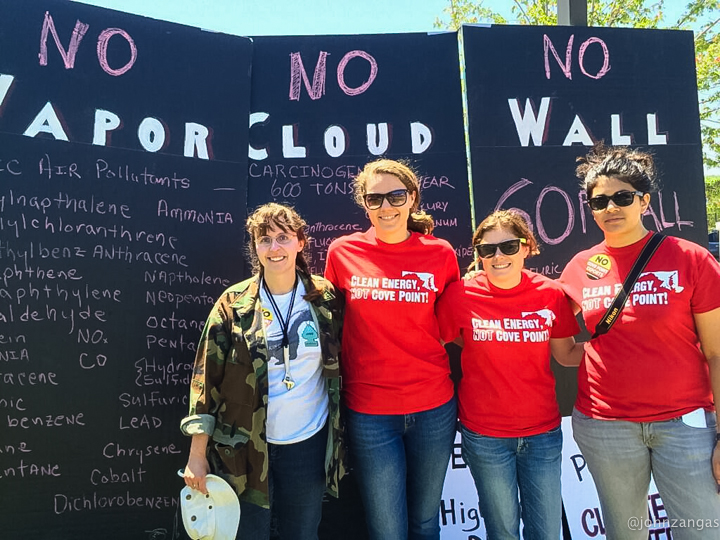 Most of all, residents want a Quantitative Risk Assessment, a thorough evaluation of safety risks posed by the plant that doesn’t rely on Dominion’s own data or mitigation plans. In 2006, during a far less extensive addition to the Cove Point facility, the state of Maryland stepped in and did a QRA when it determined that FERC’s review didn’t adequately assess hazards.
Most of all, residents want a Quantitative Risk Assessment, a thorough evaluation of safety risks posed by the plant that doesn’t rely on Dominion’s own data or mitigation plans. In 2006, during a far less extensive addition to the Cove Point facility, the state of Maryland stepped in and did a QRA when it determined that FERC’s review didn’t adequately assess hazards.
“It is inconceivable to me that FERC doesn’t see how dangerous this plant is,” said Mike Tidwell to the agency’s representatives at the hearing. “FERC seems not to want to know how dangerous this plant is. Why wouldn’t FERC want to quantify the risk for the people in this room who live so close to it?”
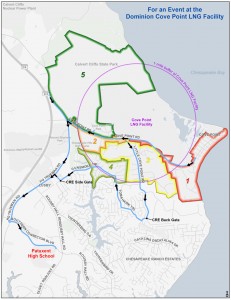 Nancy Ball, a small business owner from Lusby, asked why Dominion was relying on an overtaxed all-volunteer fire department in the event of an explosion. She also wondered how 18,000 people within a three-mile radius of the plant could be evacuated.
Nancy Ball, a small business owner from Lusby, asked why Dominion was relying on an overtaxed all-volunteer fire department in the event of an explosion. She also wondered how 18,000 people within a three-mile radius of the plant could be evacuated.
Tracey Eno of Calvert Citizens for a Healthy Community also criticized the County evacuation plan. “If there is an emergency at the plant, we’ve got to head toward the plant to get out,” she said. “We’ve got to go past the explosion, fire, road blockage, and emergency vehicles to get out.”
Although hundreds turned out for to express their views to FERC representatives, Saturday’s meeting is the only public hearing scheduled. The public comment period will close on June 16 unless FERC grants an extension as some have requested. Senators Barbara Mikulski and Ben Cardin have requested additional public hearings and an extension of the public comment period.
The rapidly shifting landscape of energy exports and the agencies regulating them have added to the drama of what is usually a highly bureaucratic and dull process. Yet another twist unfolded last week as the Department of Energy announced a change in policy regarding LNG export terminals like Cove Point. Before giving permission to export natural gas–the initial regulatory hurdle–such facilities must first undergo an environmental review. (Dominion Cove Point was not required to before it received DoE approval to export.) The DoE also issued reports on the impacts of fracking, the source of natural gas for export, and the lifecycle greenhouse gas emissions of LNG exports.
On the basis of these reports, law advocacy group EarthJustice requested an extension of the public comment period. FERC is not obligated to respond to any request, whether it be from individual, advocacy group, union, business or elected official–from County Commissioner on up to U.S. Senator. To the disappointment of many, no FERC Commissioner attended the hearing. While it’s true that FERC convened a hearing for the public on Cove Point, if it has the ability to tune them out, a “sound abatement” wall may already exist.
John Zangas contributed to this article.
- Mock “Vapor Cloud” Wall/Photo via Climate Howard
- Photo via @EnergyCitizens
- Across the street from Dominion Cove Point
- Across the street from Dominion Cove Point

